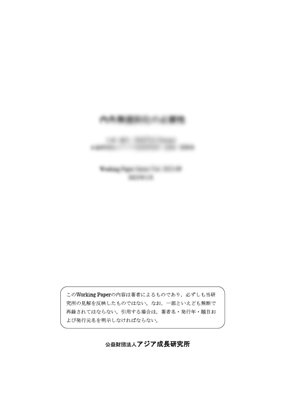Foreign Multinationals in Indonesian Manufacturing 1985-1998: Shares, Relative Size, and Relative Labor Productivity

| 執筆者 | Sadayuki Takii, Eric D. Ramstetter |
|---|---|
| 発行年月 | 2000年 9月 |
| No. | 2000-18 |
| ダウンロード | 465KB |
内容紹介
This paper examines trends in the shares of foreign multinational corporations (MNCs) in Indonesian manufacturing and then compares size and average labor productivity among locally-owned plants (establishments) and different ownership groups of foreign-owned plants (minority-foreign, majority-foreign, and heavily-foreign) in Indonesian manufacturing over the last decade. Four major patterns emerge from this investigation. First, all groups of foreign MNCs have greatly increased their shares in Indonesian manufacturing, with the most conspicuous and continuous increases observed in heavily-foreign plants. Second, all groups of foreign MNCs have tended to be larger than local plants, with majority-foreign plants tending to be the largest, followed by minority-foreign and heavily-foreign plants. Third, after controlling for the effects of industry, size, and vintage, majority-foreign plants were generally characterized by the highest levels of average labor productivity, followed by minority foreign plants. Heavily-foreign plants tended to have higher average labor productivity than local plants in the late 1980s and in 1998 but lower or equal productivity in 1990-1997. Fourth, although the results are very weak in this respect, they suggest that all groups of foreign plants generally experienced larger increases in nominal average labor productivity than local plants. Although these patterns seem to be reasonable and may well reflect the reality of Indonesia’s manufacturing sector during the period under examination, the results must be interpreted with caution for a number of reasons. One of the major reasons for caution is the fact that the so-called raw data sets used in some of the analyses here are known to have a number of problems related to non-reporting and apparently incorrect entries. Cognizant of these problems, Indonesia’s Biro Pusat Statistik compiles a separate backcast data set, which contains revised entries for a limited number of indicators, including estimates for some non-reporting establishments. An important secondary goal of this paper is thus to examine the differences between the raw data sets, which have been used in most analysis to date, and the backcast data set, with the aim of indicating how the original raw data sets may need to be modified to make more reliable analysis possible.
